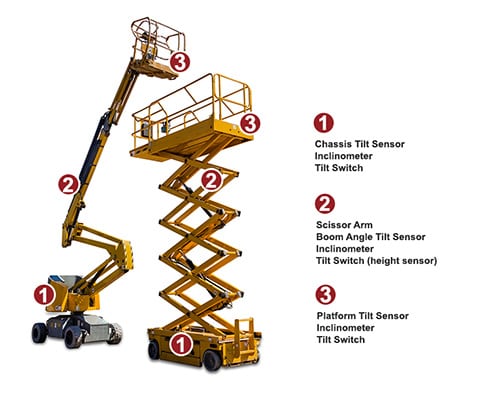如何利用倾斜传感器确保工作场所的安全?
Every year, workplace injuries and fatalities occur due to mishaps with heavy machinery operation. Luckily, products exist that help prevent these accidents from happening. Tilt sensors, switches, and inclinometers such as Fredericks’ 0729-1761-99 CAN Bus J1939 inclinometer and 0729-1736-99 tilt switch, are proven to enhance safety conditions for operators of mobile elevated work platforms (MEWPs), also known as aerial work platforms (AWPs) or elevating work platforms (EWPs).
Before we dive deeper, let’s begin with some simple definitions. The terms tilt sensor, inclinometer, and tilt switch are often used interchangeably but have specific definitions as outlined below for the purposes of this blog:
- Tilt sensor: We define a tilt sensor as the core sensing component that physically detects changes in angular position, or tilt. We specialize in electrolytic tilt sensors which are resistive fluid based sensors. Other types include, but are not limited to, liquid capacitive, force balanced (servo), MEMS, and mechanical ball bank and bubble tilt sensors.
- Inclinometer: We define an inclinometer as the core sensing component (tilt sensor) combined with electronics to provide a usable output for the end user. These units can be a simple PCB or an encapsulated unit with a connector and they provide a continuous output over the operating range of the unit. Outputs from inclinometers are connected to the MEWP vehicle controller.
- Tilt switch: A tilt switch provides an on/off signal when the unit is tilted past specified tilt angles. These can be single or dual axis and typically have relay or open collector outputs. This allows actuation of hydraulics or machine shut off once the vehicle reaches an unsafe angle during operation.
MEWP事故可能发生在剪刀式升降机、高空设备(如伸缩式(远距离搬运机)或铰接式吊杆升降机)和垂直桅杆升降机上。最常见的MEWP事故包括:
- Entrapment: An operator becoming trapped between the MEWP and a fixed structure
- Overturning: Ground conditions, such as the slope or pressure, causing the MEWP to overturn
- Falling: An operator falling from the MEWP platform
- Collisions: The MEWP colliding with pedestrians, other vehicles, or power lines
To avoid these common mishaps from occurring in your place of work, learn how the right tilt sensors, inclinometers, and tilt switches can improve the safety, and ultimately the productivity, of your team:
- Monitoring the Chassis Tilt Angle: Chassis angle measurement guarantees that the base of the MEWP is within safe angle limits for vehicle operation. If the sensor indicates the vehicle is in an unsafe position for operation, the MEWP vehicle controller can inhibit the operator’s ability to take actions like extending or moving the boom on a boom lift, or increasing the platform height on a scissor lift, among many other things. Because the operator is prevented from taking these actions, the likelihood of an overturn or a fall is significantly reduced.
- Monitoring the Platform Tilt Angle: Platform angle measurement guarantees that the platform of the vehicle is level with the chassis of the vehicle and can be used in conjunction with other sensors to allow the MEWP vehicle controller to do load calculations. This can prevent an unsafe load which could cause the vehicle to overturn or the operator to fall.
- Monitoring the Platform Height: Platform height is a function of the scissor lift arm angle or the boom angle, so angle measurement allows the MEWP vehicle controller to calculate the platform height and combine it with information from other sensors to do load calculations. Again, this can prevent unsafe loads which could cause the vehicle to overturn or the operator to fall.

以下是在为MEWP应用选择倾斜传感器、倾角计和倾斜开关时需要注意的一些关键特性。
- Accuracy: Ensure you understand the accuracy of the unit you’re considering. Suppliers often interchange the definitions of accuracy, repeatability, and linearity, to prevent the end-user from understanding the true accuracy of a device. But it’s important that your tilt sensor, inclinometer, or tilt switch provides an accurate output during the vibration experienced on a MEWP.
- Integration: Make sure you select the correct output for your tilt sensor, inclinometer, or tilt switch to make the integration process as simple as possible.
- Environmental protection and certifications: Ensure that the tilt sensor, inclinometer, or tilt switch you select has sufficient environmental protection, such as an IP rating, and that it has the necessary certifications and compliance, such as CE, UL, RoHS, or REACH.
- Price: Feature rich and/or extremely high accuracy tilt sensors, inclinometers, and tilt switches can seem like an attractive option, but often their price is prohibitive for OEM applications.
For more information on tilt sensors, switches, and inclinometers, contact us today.
如果您对客座博客机会感兴趣,请致电 215.938.4422 联系 Shawn Orr。
返回博客





